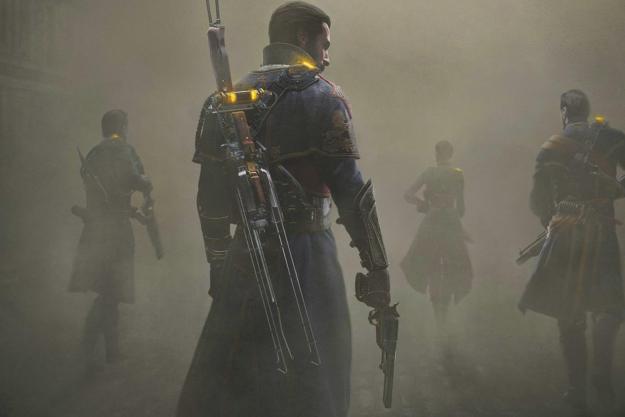
“The Order: 1886 is a dull, plodding experience that's beautiful to behold but spends too little time giving players a reason to stick around.”
- It's a real looker
- Too much emphasis on watching over playing
- The shooting that makes up the bulk of the gameplay is dull and uninspired
- Change of pace moments, particularly stealth, are poorly executed
- In short: It's just not fun
I’m sitting here noshing on some leftover Chinese food while the end credits for The Order: 1886 play in the background, and I’m not quite sure what to say. There’s a malaise that settles in about 20 minutes into the game, a “what the hell is going on?” kind of feeling that flits around on the edges of your consciousness for the game’s definitively more than five-hour playtime (probably in the five to seven range for most).
The word “play” applies very loosely in the case of The Order, bloated as it is with excruciatingly dull cutscenes and mindless push-the-button-to-make-some-cool-thing-happen moments. Quick time events, or QTEs, as the kids of the ’90s and early Aughts called them. Yes, The Order is an anachronism, but the problem is it’s not a very good one.
The word “play” applies very loosely in the case of The Order, bloated as it is.
Not for lack of trying. The backdrop is an intriguing Victorian steampunk take on London where foul, sharp-clawed creatures lurk in the dark. Werewolves, and other terrible things of that nature. The round table of knights assembled by King Arthur lives on as a secret order of defenders against supernatural threats. The men and women making up its ranks are ageless, sustained by Black Water, an unidentified liquid that heals devastating wounds and staves off natural death.
Sir Galahad — all member knights take on the name of a circle founder, you see — is a prisoner of his own people, subject to torture for crimes that aren’t initially clear. A daring escape leaves the disgraced knight in a near-death embrace, opening the way to a flashback that follows the order’s recent struggles against local rebels, a deranged killer, and squabbles within. All of the pieces connect somehow, and they all lead to Galahad waiting for death in a cell.
Most of this comes out during The Order’s opening salvo of sequences, which serve double duty as plot advancers and control tutorials. The escape happens, the flashback fires up… and the slow reveal continues. You’re ambling lazily through the alleyways of London, following a single path that might as well be adorned with signs that read “This is a video game hallway.” The world is strangely lifeless, with very little of the city’s hustle and bustle evident in the background.

By the time the action arrives, you’ve nearly given up. The Order delivers its third-person, cover-based shooting in brief chunks, peppering in occasional QTEs (sigh), monster fights (repetitive), stealth (UGH), and walking & talking. The closest comparison is Gears of War, but even that prototypical 2006 effort is light years ahead of 1886 when it comes to strategic nuance and in-your-face action.
To call the pace glacial is forgiving. I frequently found myself dozing off during the four or five play sessions it took to knock through the game’s 16 chapters. There may be someone out there that gets really into the story and hangs on every word, but I am not that person. A dull, predictably twist-laden plotline and stuffy voice performances — this may be Victorian England, but come on and lighten up a bit – render everything in a light, buzzing drone. Some game stories demand investment and some zone you out. This is very much the latter.
At least it’s pretty. The Order: 1886 is right up there alongside the far more interesting Infamous: Second Son in terms of looks. The visual fidelity developer Ready at Dawn squeezed out of the PlayStation 4 is commendable. You don’t care what any given character is saying most of the time, but you’re spellbound by how expressive his or her face is. They’re not photorealistic creations, but you can read a surprisingly nuanced range of emotions.
The Order is a game that gives good screenshot, and little else.
As static as London feels while you walk and shoot your way through it, the level of detail is eye-catching in still life. Most of the time, the illusion shatters under closer inspection. Cobblestone streets and product-filled storefronts amount to painted on stickers that look great from a distance but lack physical texture of any kind. The Order‘s shooting galleries are dotted with destructible bits and pieces, like display cases or the occasional exploding barrel (red, naturally). But that’s the extent of what you can do to the world around you. The Order is a game that gives good screenshot, and little else.
You can see promise peeking around the edges on occasion. Some noteworthy gun falls into you lap or a fresh type of enemy appears. You modify your strategy accordingly, and fleetingly hope that this is the pivot moment, the point at which everything falls into lockstep. But then the gun is replaced by a cutscene or the new baddie’s easily uncovered weakness is revealed — Protip: Most of the time, it’s “shoot until dead” — and the malaise seeps back in.
That’s the thing: The Order could be a broken mess, but I’d have attacked it excitedly throughout the review if it had done anything even teasingly original. Instead, it’s just a scaled back take on a genre that’s been done a whole lot better many times before. A genre that also happens to have fallen out of vogue.
Was Sony hoping Ready at Dawn’s efforts revived cover-based third-person shooters while also establishing a new PlayStation franchise to rival Gears? If so, that hope was as vain as The Order itself is. This game might have slipped by with middling reception as a PlayStation 4 launch title, but coming now, in the midst of giants like Shadow of Mordor and Destiny, it feels desperately out of place.
So now I’m sitting at my desk with an empty carton of deceased leftovers next to me and a document full of words staring out from the computer monitor… and I’m still not sure what to say. The Order: 1886 is a terrible game. Not because it’s broken or made without skill. Certainly not because it’s an average-length, story-driven shooter with minimal replay value. It’s just a bad game, forgettable in every conceivable way and safely ignored by all but the most ardent Trophy hunters.
This game was reviewed on a PlayStation 4 using a disc provided by Sony.
Highs
- It’s a real looker
Lows
- Too much emphasis on watching over playing
- The shooting that makes up the bulk of the gameplay is dull and uninspired
- Change of pace moments, particularly stealth, are poorly executed
- In short: It’s just not fun






